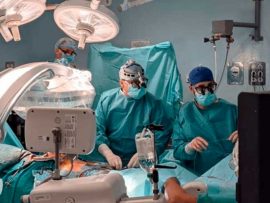Abstract Background The experience of a percutaneous microaxial (Impella) in children with is limited. The primary objective of this study was to review our institutional clinical outcomes of Impella use in children..
Read MoreAbstract Terminal heart failure presents challenges, requiring cardiac transplantation, or mechanical circulatory support. Limited donor organ availability has made mechanical support crucial. Advances in centrifugal-flow systems, compared to axial-flow, have..
Read MoreAbstract Background: Acute right ventricular failure is a critical complication after left ventricular assist device (LVAD) implantation, often managed with a temporary paracorporeal right ventricular assist device (RVAD). This study..
Read MoreAbstract Heart transplantation and left ventricular assist devices (LVADs) have emerged as crucial interventions for end-stage heart failure, dramatically improving patient outcomes. This narrative review examines their historical context, indications,..
Read MoreAbstract Patients on left ventricular assist devices (LVAD) are prone to excessive hemostasis disturbances due to permanent contact of artificial pump surfaces with blood components. We aimed to investigate if..
Read MoreAbstract Mechanical circulatory support with implantable durable continuous-flow left ventricular assist devices (CF-LVADs) represents an established surgical treatment option for patients with advanced heart failure refractory to guideline-directed medical therapy...
Read MoreAbstract Background Patients requiring biventricular support (BIVAD) face higher morbidity than those undergoing durable left ventricular assist device (LVAD) implantation alone. The goal of the current study was to evaluate..
Read MoreAbstract Despite technological advances in left ventricular assist device (LVAD) technology, which have made survival competitive with heart transplantation at 2 years, right ventricular failure (RVF), with an incidence of..
Read MoreAbstract Right ventricular failure (RVF) is a significant cause of mortality in patients undergoing left ventricular assist device (LVAD) implantation. Although right ventricular assist devices (RVADs) can treat RVF in..
Read MoreAbstract Right heart failure (RHF) management after left ventricular assist device (LVAD) implantation includes inotropes, right ventricular mechanical support, and heart transplantation. The purpose of this study is to compare..
Read MoreAbstract Introduction: The need for preoperative extracorporeal membrane oxygenation (ECMO) support prior to left ventricular assist device(LVAD) therapy has been associated with increased mortality. Our study investigated the impact of de-escalating..
Read MoreAbstract Left ventricular assist device (LVAD)–induced hemodynamics are characterized by fast-moving flow with large variations in velocity, making quantitative assessments difficult with existing imaging methods. This study demonstrates the ability of..
Read MoreBy Stephanie Louka, MD Case scenario: Paramedics are called to the home of a 59-year-old male patient with an LVAD who was found unconscious and unresponsive by family members. He..
Read MoreAbstract Background Clinical trials inform on average efficacy, but individualized risk assessments for outcome prediction are important in guiding treatment implementation. Objectives The authors developed and validated a patient-specific risk..
Read MoreAbstract Left ventricular assist devices (LVADs) are safer and provide better survival and better quality of life than biventricular assist devices (BVADs) but end-stage heart failure often involves both ventricles,..
Read MoreAbstract We describe three successful cases of HeartMate left ventricular assist device (LVAD; Thermo Cardiosystems, Woburn, MA, USA) implantation in patients with end-stage heart failure for long-term circulatory support. Patient..
Read MoreAbstract There are limited data on the characteristics and clinical course of fungal infections in patients on durable left ventricular assist device (LVAD) support. We sought to further characterize the..
Read MoreAbstract Introduction Although the established long-term benefit of left ventricular assist device (LVAD) therapy has led to its proliferation as destination therapy (DT), few studies have evaluated LVAD outcomes at..
Read MoreAbstract Titanium alloys have traditionally been used in blood-contacting cardiovascular devices, including left ventricular assist devices (LVADs). However, titanium surfaces are susceptible to adverse coagulation, leading to thrombogenesis and stroke...
Read MoreAbstract As the prevalence of advanced heart failure continues to rise, treatment strategies for select patients include heart transplantation or durable left ventricular assist device (LVAD) support, both of which..
Read MoreAbstract Early right heart failure (RHF) occurs in up to 40% of patients following left ventricular assist device (LVAD) implantation and is associated with increased morbidity and mortality. The most recent..
Read MoreAbstract Secondary mitral valve regurgitation is a frequent consequence of left ventricular dysfunction in patients with severe heart failure. The management of this disease can be challenging since it often..
Read MoreAbstract Peripheral venoarterial extracorporeal membrane oxygenation (VA ECMO) for acute cardiac failure reestablishes normal oxygen delivery and perfusion. However, VA ECMO can be limited by insufficient ventricular unloading, resulting in..
Read MoreAbstract Background A relation between the left ventricular assist device inflow cannula (IC) malposition and pump thrombus has been reported. This study aimed to investigate if the pump position, derived..
Read MoreAbstract Background Within the past ten years, continuous-flow Left Ventricular Assist Devices (LVADS) have replaced pulsatile-flow LVADs as the standard of care for both destination therapy and bridging patients to..
Read MoreAbstract Cardiogenic shock is associated with high mortality. Patients often require temporary mechanical circulatory support. We aimed to develop a percutaneously implantable, assist device that unloads the left ventricle (LV)..
Read MoreAbstract Background: There has been increasing use of extracorporeal membrane oxygenation (ECMO) as bridge to heart transplant (orthotopic heart transplant [OHT]) or left ventricular assist device (LVAD) over the last..
Read MoreAbstract Left ventricular assist devices (LVADs) have been increasingly used as a therapy for patients with end-stage heart failure. However, a growing number of clinical observations have shown that LVADs..
Read MoreAbstract Background Extracorporeal cardiopulmonary resuscitation (eCPR) is a rapidly growing treatment strategy due to increasing survival rates in selected patients. Additional left ventricular mechanical unloading, using a transfemoral micro-axial blood..
Read MoreAbstract Current guidelines recommend serial right heart catheterization (RHC) to survey pulmonary hypertension in patients awaiting heart transplant. However, the role and impact of this surveillance is unclear in patients..
Read More










